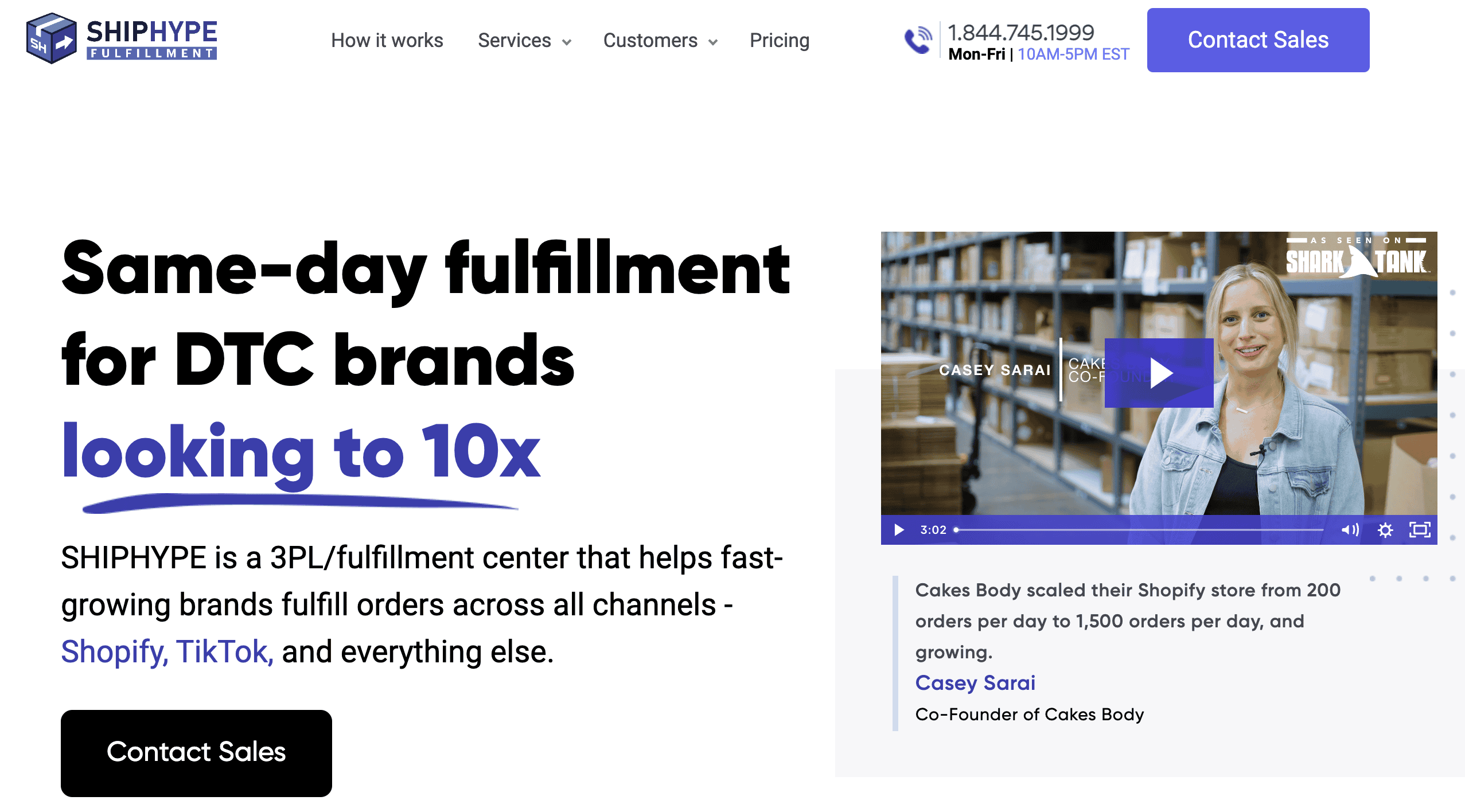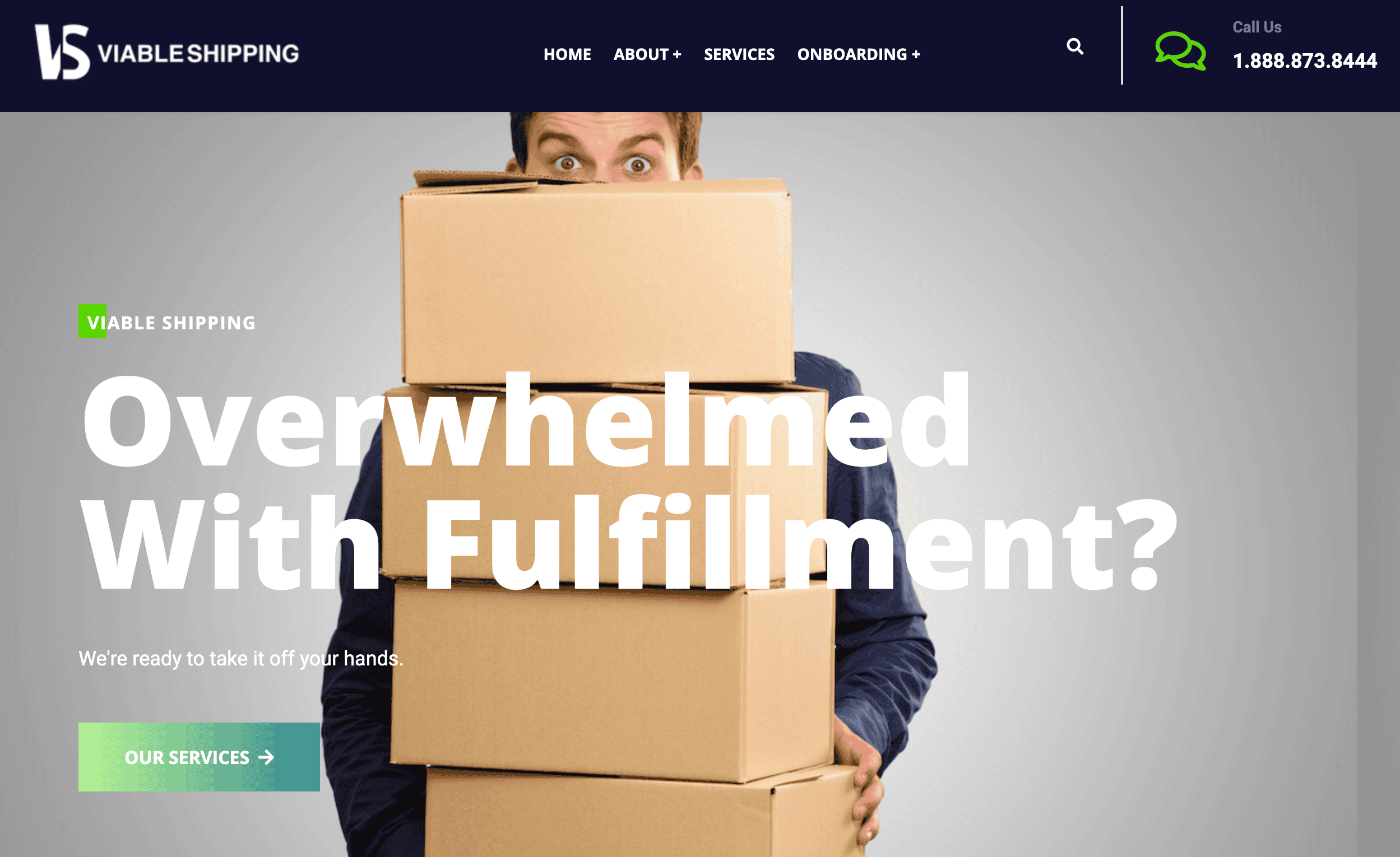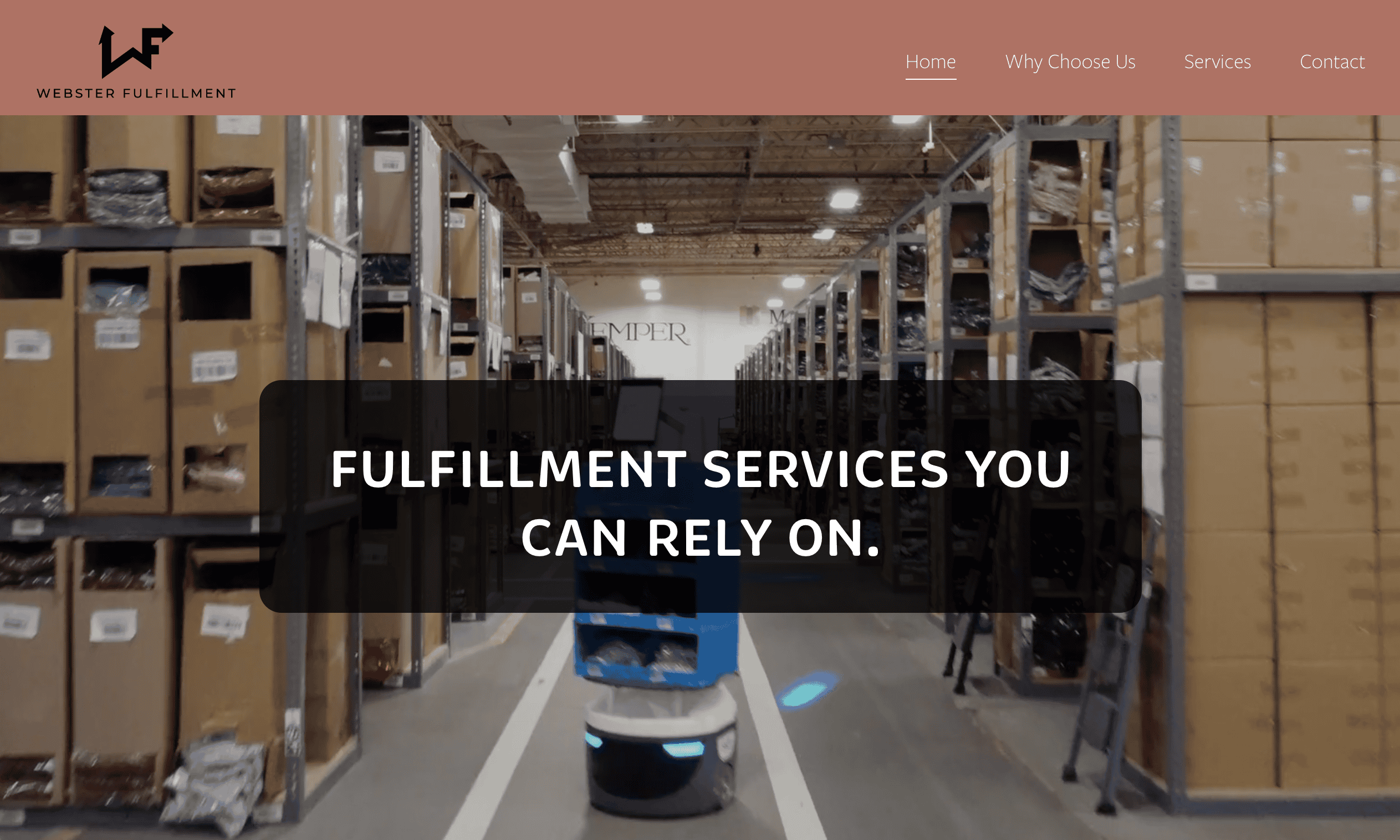Third-party logistics companies (3PLs) can handle logistics and supply chain management for small businesses, allowing them to focus on their core services and grow their operations. With the right 3PL partner, you won’t need to worry about order fulfillment, warehousing, return management, or shipping anymore.
Here, we’ll cover how to know when it’s time to work with a 3PL, what to look for in a provider, and give you our top four best 3PL options for small business owners:

TL;DR:
Small business 3PL essentials

Top small business 3PLs include SHIPHYPE, Viable Shipping, Webster Fulfillment, and Redhawk, each with unique specialties for different business needs.

Consider a 3PL when you’re struggling with inventory management, timely shipping, high shipping costs, or limited logistics expertise.

Small businesses should look for cost-effectiveness, scalability, integration capabilities, and reliability when choosing a 3PL partner.

The right 3PL partnership allows you to focus on your core business while experts handle your logistics operations.

NOTE: You may have noticed that we (Red Stag Fulfillment) are not on this list. That’s because we’re upfront about the fact that we aren’t always the best 3PL fit for every ecommerce company out there.
Our goal isn’t to convince you to partner with us. It’s to help you find the best solution for you. If we’re not a good fit, we’ll connect you with a 3PL who is better suited for your needs.
Ready for a 3PL partnership that truly fits? Fill out our form to start a conversation.
4 3PL partners for small businesses to consider
Not every 3PL will be the right choice for every small business, but these four 3PLs offer the cost-effective solutions, scalability, and reliability that small businesses value.
SHIPHYPE
01

Core services:

Order fulfillment

Inventory management

FBA prep
SHIPHYPE is a 3PL that offers scalable solutions for ecommerce businesses, including direct-to-consumer (DTC) wholesale fulfillment. Their user-friendly platform integrates with Amazon and Shopify, allows clients to easily manage their orders and inventory, and provides data insights to improve operations.
Strong customer support is a standout feature of SHIPHYPE. Their dedicated account managers are available to assist with any concerns or issues, creating a smooth experience for their clients.
They also offer fulfillment by Amazon (FBA) prep services, which allow businesses to outsource the time-consuming and complicated process of preparing goods for Amazon fulfillment.
Viable Shipping
02

Core services:

Order fulfillment

Warehouse management

Freight management
Viable Shipping offers flexible solutions that can easily accommodate changing order volumes, so they’re ideal for startups and growing businesses. Their competitively priced services and reliable fulfillment make them popular among businesses looking to reduce costs.
Their services include B2B and FBA shipments, inventory management, and freight management to simplify shipping processes across the board and provide timely delivery.
They also offer warehousing and storage solutions for businesses needing additional space or looking to outsource this aspect of their operations. Their platform integrates with over 80 marketplaces and shopping carts, providing online retailers a seamless fulfillment experience.
Webster Fulfillment
03

Core services:

Pick and pack services

Order fulfillment

Inventory management

Returns processing
As a comprehensive 3PL service provider, Webster Fulfillment offers a range of services to support businesses’ logistics needs. From fulfillment to pick and pack services, inventory management, and returns processing, they have everything covered under one roof.
Their integrated platform shows inventory levels and order status, making it easier for businesses to manage their operations. They also offer advanced technology integrations, including EDI and API connections, to streamline processes and eliminate manual data entry errors.
Redhawk
04

Core services:

Last-mile delivery

Order fulfillment

Returns processing

Inventory management
Redhawk caters primarily to ecommerce businesses and brands that demand efficient and dependable logistics services. Their core services include comprehensive fulfillment, inventory management, last-mile delivery, and returns processing.
Redhawk’s unique offerings center around a commitment to reliable, secure, and timely shipping. They offer flexible solutions tailored to each client’s specific needs, making it easier for businesses to adapt to changing market conditions.
With a strong focus on customer satisfaction, Redhawk’s team provides excellent support and communication throughout the fulfillment process. They also offer affordable shipping rates through their partnerships with major carriers, making them a cost-effective choice.
How do you know it’s time for your small business to work with a 3PL?
Any business can benefit from outsourcing its logistics operations, but it’s a huge change to make — especially if you’ve been handling everything in-house so far. You have to move inventory, hand over control to a 3PL provider, figure out the best way to communicate and collaborate with a third party, and reallocate the budget to accommodate the service.

But for many small businesses, a time will come when a 3PL becomes the most efficient option to keep operations running smoothly, such as when you begin to experience:

Challenges with managing inventory and stock levels

Difficulty meeting customer demand and shipping orders on time

High shipping costs that eat into profits

Limited resources and expertise in handling logistics operations

Inability to keep up with changing industry regulations and compliance requirements
To stay proactive, small businesses should regularly assess their logistics needs and look for areas for improvement. Outsourcing to a 3PL can allow small businesses to focus on growth and expansion, rather than getting bogged down by logistics.
3PL features that small businesses typically seek out
Your small business is unique, and its logistics needs will differ from the next company — even your closest competitor. Consider what you need out of your 3PL partnership and look for a provider that fits your requirements. Some features small businesses typically prioritize include:

PRO TIP: Before committing to a 3PL partner, create a detailed list of your specific requirements and priorities. This will help you evaluate potential providers more effectively and ensure you find one that truly meets your business needs.
Cost-effectiveness
Small businesses often operate on tighter budgets and with fewer resources than larger companies. Every dollar saved on logistics can be reinvested into the business for growth and expansion.
A 3PL with a broad network of distribution centers can provide faster delivery times and lower shipping costs. This, in turn, enhances customer satisfaction and encourages repeat business, which ultimately leads to business growth.
Scalability
A suitable 3PL allows you to adjust services based on demand, so you can handle busy seasons without hiccups. The 3PL partner you choose should help you manage increased order volumes during peak seasons or promotional events without overwhelming internal resources.
This scalability is essential for small businesses, allowing them to quickly adapt to changing consumer demand and market conditions. A well-rounded 3PL can handle a diverse range of products, storage needs, and shipping requirements to accommodate your changing needs as your business grows.
Integration capabilities
Why spend time manually transferring data between systems when a 3PL can seamlessly integrate with your existing ecommerce platform, ERP system, and other business software?
These integrations save time, reduce the risk of human error, and give you and your customers access to more tools and features like real-time tracking and automated order processing. These capabilities contribute to smoother operations and the growth and scalability that small businesses strive for.
Accuracy and reliability
Accurate order fulfillment is essential for customer satisfaction and repeat business. To minimize errors, a 3PL partner should have reliable systems in place, plus effective quality control and return management processes.

Consistent and accurate order management builds customer trust, increasing their likelihood of brand loyalty. Errors in order fulfillment, on the other hand, result in frustration, negative reviews, and costly returns, which can cripple small businesses striving to maintain a competitive edge.
Efficient return management also plays a critical role in shaping customer experience. A smooth, hassle-free return process can turn a negative experience into a positive one.
Frequently asked questions

What size business typically works with a 3PL?
Businesses of all sizes work with 3PLs, from small startups to large enterprises. Small businesses often partner with 3PLs when they’re experiencing growth that makes in-house fulfillment challenging, when they need specialized logistics expertise, or when they want to focus more resources on core business functions rather than fulfillment operations.






How much does it cost to work with a 3PL?
3PL pricing varies widely based on the services required, volume of orders, storage needs, and other factors. Most 3PLs charge for receiving inventory, storing products, picking and packing orders, and shipping. Small businesses typically pay between $3-10 per order plus storage fees, though this can vary significantly. Many 3PLs offer volume-based discounts that can reduce per-order costs as your business grows.
How to choose a 3PL partner that won’t let you down
When choosing the right 3PL company for your small business, focus on reliability, customer support, and service quality. These key factors will directly impact your customers’ experiences and your business’s success.
Start by researching different 3PL or fulfillment providers and talking to their sales representatives to understand their services, pricing, and overall approach.

NOTE: Look beyond the cost and consider efficiency, speed, and added services like kitting or custom packaging. A cost-effective 3PL partner may not necessarily be the cheapest but one that offers the best value for your business.
Thoroughly research and vet potential 3PL partners by reading customer reviews, case studies, and testimonials. These can provide valuable insights into each provider’s quality of service and reliability. Look for companies with experience working with businesses similar to yours and a proven track record of success.
Once you’ve narrowed down your options, consider conducting a trial period or pilot project with your top choices. This will allow you to assess their compatibility and performance before committing to a long-term partnership.
Get connected with the right 3PL for your small business today
Outsourcing fulfillment to a third-party logistics provider can be an excellent solution for small businesses looking to streamline their operations and focus on growth. The right 3PL partner should offer reliable shipping, flexible solutions, and strong customer support — cost-effectively.
While Red Stag Fulfillment isn’t always the best fit for small businesses, we still encourage you to start a conversation with us. If our services don’t align with your needs, we’ll even help you find a 3PL partner that is right for you.
Ready to find your perfect 3PL match?
If you’re ready to explore whether Red Stag is the right choice for your business, reach out to discuss your needs. Even if we’re not the perfect fit, we’ll help you find a 3PL partner who is.
Talk With Us









